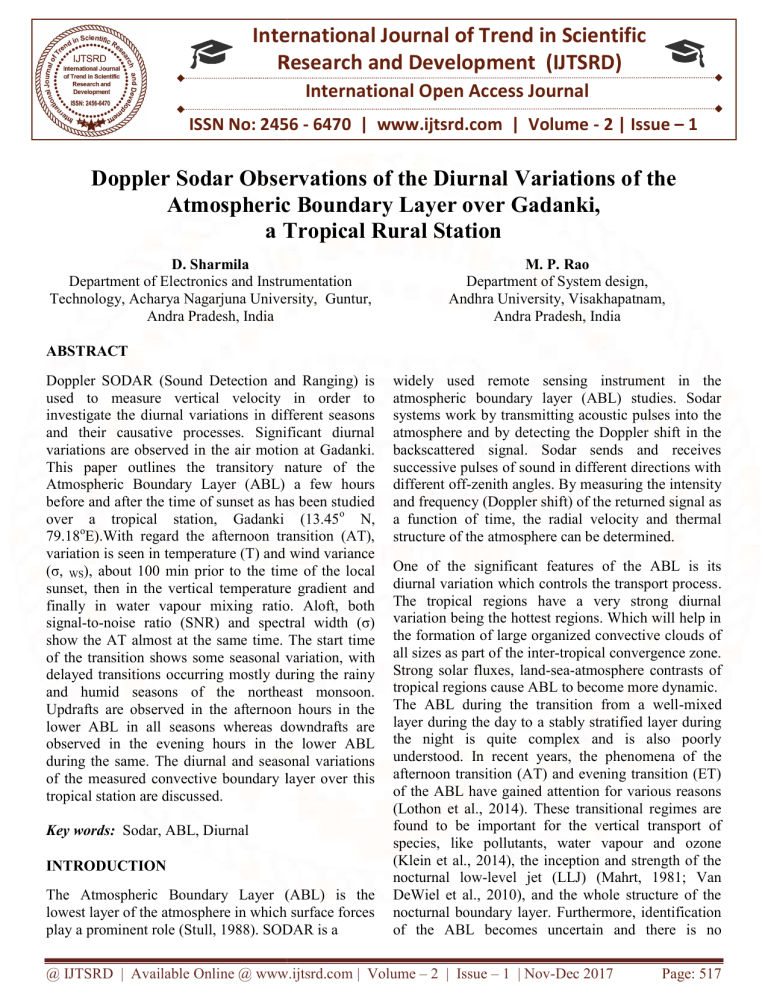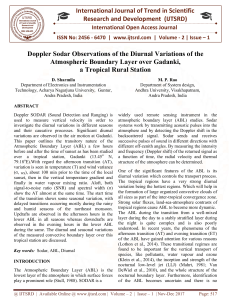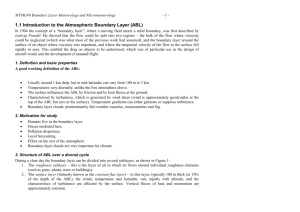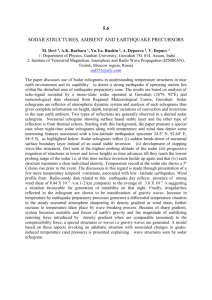
International Journal of Trend in Scientific
Research and Development (IJTSRD)
International Open Access Journal
ISSN No: 2456 - 6470 | www.ijtsrd.com | Volume - 2 | Issue – 1
Doppler Sodar Observations of the Diurnal Variations of
o the
Atmospheric Boundary Layer oover
ver Gadanki,
a Tropical Rural Station
D. Sharmila
Department of Electronics and Instrumentation
Technology, Acharya Nagarjuna University, Guntur,
Andra Pradesh, India
M. P. Rao
Department of System design,
Andhra University, Visakhapatnam,
Andra Pradesh, India
ABSTRACT
Doppler SODAR (Sound Detection and Ranging) is
used to measure vertical velocity in order to
investigate the diurnal variations in different seasons
and their causative processes. Significant diurnal
variations are observed in the air motion at Gadanki.
This paper outlines the
he transitory nature of the
Atmospheric Boundary Layer (ABL) a few hours
before
efore and after the time of sunset as has been studied
over a tropical station, Gadanki (13.45 o N,
79.18oE).With regard the afternoon transition (AT),
variation is seen in temperature (T) and wind variance
(σ, WS), about 100 min prior to the time of the lo
local
sunset, then in the vertical temperature gradient and
finally in water vapour mixing ratio. Aloft, both
signal-to-noise
noise ratio (SNR) and spectral width (σ)
show the AT almost at the same time. The start time
of the transition shows some seasonal variati
variation, with
delayed transitions occurring mostly during the rainy
and humid seasons of the northeast monsoon.
Updrafts are observed in the afternoon hours in the
lower ABL in all seasons whereas downdrafts are
observed in the evening hours in the lower ABL
during the same. The diurnal and seasonal variations
of the measured convective boundary layer over this
tropical station are discussed.
Key words: Sodar, ABL, Diurnal
INTRODUCTION
The Atmospheric Boundary Layer (ABL) is the
lowest layer of the atmosphere in which surface forces
play a prominent role (Stull, 1988). SODAR is a
widely used remote sensing instrument in the
atmospheric boundary layer (ABL) studies. Sodar
systems work by
y transmitting acoustic pulses into the
atmosphere and by detecting the Doppler shift in the
backscattered signal. Sodar sends and receives
successive pulses of sound in different directions with
different off-zenith
zenith angles. By measuring the intensity
and frequency (Doppler shift) of the returned signal as
a function of time, the radial velocity and thermal
structure of the atmosphere can be determined.
One of the significant features of the ABL is its
diurnal variation which controls the transport process.
process
The tropical regions have a very strong diurnal
variation being the hottest regions. Which will help in
the formation of large organized convective clouds of
all sizes as part of the inter-tropical
tropical convergence zone.
Strong solar fluxes, land-sea--atmosphere contrasts of
tropical regions cause ABL to become more dynamic.
The ABL during the transition from a well-mixed
well
layer during the day to a stably stratified layer during
the night is quite complex and is also poorly
understood. In recent years, the phenomena
phen
of the
afternoon transition (AT) and evening transition (ET)
of the ABL have gained attention for various reasons
(Lothon et al., 2014). These transitional regimes are
found to be important for the vertical transport of
species, like pollutants, water
wate vapour and ozone
(Klein et al., 2014), the inception and strength of the
nocturnal low-level
level jet (LLJ) (Mahrt, 1981; Van
DeWiel et al., 2010), and the whole structure of the
nocturnal boundary layer. Furthermore, identification
of the ABL becomes uncertain
uncerta and there is no
@ IJTSRD | Available Online @ www.ijtsrd.com | Volume – 2 | Issue – 1 | Nov-Dec
Dec 2017
Page: 517
International Journal of Trend in Scientific Research and Development (IJTSRD) ISSN: 2456-6470
consensus on which scaling law (day-time convective
scaling due to surface buoyancy flux or nocturnal
boundary layer scaling due to surface wind stress)
would work well during this period (Pino et al.,
2006).Furthermore, the start time of the transition and
its duration could be different at the surface and aloft
because the turbulence may not immediately dissipate
after sunset (Busse and Knupp, 2012).
The temperature in this layer differs diurnally and
seasonally, which further alters the pressure that
results in the fluctuation of the wind. The pace of the
wind rises along with height; and its path is
disordered because of the topographical environment
(Taylor & Garratt, 1996).Usually, ABL altitude shows
high diurnal difference during the monsoon and the
post-monsoon months, and being relatively lesser in
the pre-monsoon season and the winter. ABL altitude
peaks at the noon time during all seasons (~1400 IST)
and stays high until the evenings (~1700 IST) just
before sunset. The ABL altitude starts reducing
because of the cooling after sunset and attains the
lowest level after midnight (~0200 IST) and
commences repeatedly to rise post sunrise (~0800
IST). The ABL differs largely from evening to early
morning during the monsoon and post-monsoon
seasons, as there is greater difference from late
midnight to early morning during the pre-monsoon
seasons and all through the day in the winter months
(Mehta et al., 2017).
Some studies employed models to understand the
occurrence of different types of transition (Brazelet
al., 2005; Edwards et al., 2006; Pino et al., 2006;
Sorbjan,2007; Nadeau et al., 2011; Sastre et al.,
2012). Brazelet al. (2005) studied the evening
transition under weak synoptic forces that favour the
local thermal circulations, and compared the observed
transitions with models. In advance,Sastre et al.
(2012) determined three types of evening transitions
and evaluated the performance of the Weather
Research and Forecasting Advanced Research (WRFARW) model in reproducing these transitions by
varying PBL parameterization schemes. They noted
that all parameterizations reproduced the observed
behavior of AT under certain circumstances. Noting
the need to understand the transitions in a better way,
several field campaigns were conducted in recent
years, employing both in situ and remote sensors,
exclusively for better characterization and modeling
of the transitions of the Boundary Layer Late
Afternoon and Sunset Turbulence (BLLAST)
(http://bllast.sedoo.fr) (Lothon et al., 2014) and the
Phoenix Evening Transition Flow Experiment
(TRANSFLEX) (Fernandoet al., 2013). Recently,
manned and unmanned aerial vehicles were used to
study the vertical structure of the lowest part of the
ABL during the AT (Bonin et al., 2013; Lothonet al.,
2014).
This paper summarizes the diurnal variation of ABL.
The variation of different state variables at the surface
and aloft is studied with the help of a case study.
System Description
The National Atmospheric Research Laboratory
(Gadanki) is a tropical rural station located at
(13.45oN, 79.18oE) in South India. This site is located
nearly 375m above the mean sea level in a rural area
in southeastern peninsular India and is surrounded by
hillocks (300–800m within a 10 km region)
distributed in a complex fashion. The rainfall in this
region is influenced primarily by two monsoons,
southwest monsoon (June–September) and northeast
monsoon (October–December) (Rao et al., 2009).
Phased Array Doppler SODAR installed at NARL is
used for the present study; this system has been
operating in the frequency range of 1800–2500 Hz
with an acoustic power (output) of 100 W. This
system consists of 8×8 array of antenna elements.
With beams tilted from zenith in the east and north
directions, all three components of the wind velocities
and other scattering parameters (power, signal-tonoise ratio, etc.) between the heights of 30–1500m are
determined. Anandan et al (2008) have described the
technical specifications of the NARL SODAR system,
signal processing, data quality control and preliminary
validation of the system data products. The SODAR
system technical specifications are shown in table 1.1.
@ IJTSRD | Available Online @ www.ijtsrd.com | Volume – 2 | Issue – 1 | Nov-Dec 2017
Page: 518
International Journal of Trend in Scientific Research and Development (IJTSRD) ISSN: 2456-6470
Table 1.1 Important Technical Specifications of SODAR, NARL.
Parameter
Operating frequency
Peak power
Antenna array
Number of elements
Pulse width
Inter pulse period (µs)
No. of coherent integrations
No. of incoherent integrations
No. of FFT points
Beam width (deg)
Range resolution (m)
Beam directions
The range-time plots of spectral moments SNR, σ,
WS, ω from sodar is examined for the clear growth
and decay of ABL and convection/precipitation
contamination (Grimsdell et al., 2002; Rao et al.,
2008). Data from theyear 2010is considered for the
present study as a function of the season. Though
considerable data were filtered out in the rainy
seasons (southwest and northeast monsoons), the
number of available days is large enough to represent
the season. Measurements from the selected days are
used to understand the behavior of AT at different
altitudes.
Figure 1 shows the diurnal variation of surface state
variables of sodar SNR, horizontal wind speed, σ,
WS, ω and wind direction on February10, 2010,
providing an evolution of the transitional boundary
layer at the surface and aloft. The surface state
variables exhibit larger variations during the transition
period than during the rest of the night. Figure 1shows
the transition of the ABL from a highly convective to
a more stable regime. The backscatter for Sodar
depends on the refractive index irregularities caused
primarily by turbulence-driven temperature and
humidity variations. The SNR is, therefore, high
during the day when the convectively driven
turbulence is active. Nevertheless, about 2 hours
before sunset, both the intensity and vertical extent of
Specifications
1.8KHz
100 W
1m x1m Phased array
52
180 m/s
9X106
1
1
4096
4
30
N 16, Z, E 16
thermals start to decrease continuously till the sunset
occurs. The minimum backscatter (SNR) is seen just
before the sunset, mainly due to the weak turbulence.
The magnitude of backscatter and vertical extent of
Sodar data again increase in accordance with the
deepening of the inversion layer. As noted by Busse
and Knupp (2012), the winds within the nocturnal
boundary layer generally decrease during the AT, but
increase above the nocturnal boundary layer. It makes
the identification of the start time of the AT using
wind speed somewhat ambiguous. On the other hand,
it is rather easy to identify the start time of the AT
from the variations of SNR and σ. The wind direction
does not change much with altitude below 1.5km and
remains mostly easterly to southeasterly.
The Sodar backscatter, depends primarily on turbulent
irregularities of refractive index, decreases with the
waning of sensible heat flux (and thermals) during the
afternoon transition. On 10 February 2010, the SNR
of sodar starts to decrease about 2 h 40 min prior to
the time of sunset at all heights. Interestingly, the start
time of SNR reduction shows height dependence with
higher altitudes showing the reduction earlier. The
SNR minimum is observed 10–20 min before sunset
at all heights, mainly due to the reduction in turbulent
fluctuations in temperature. Nevertheless, the SNR
increases again after sunset, following the formation
of an inversion layer.
@ IJTSRD | Available Online @ www.ijtsrd.com | Volume – 2 | Issue – 1 | Nov-Dec 2017
Page: 519
International Journal of Trend in Scientific Research and Development (IJTSRD) ISSN: 2456-6470
Figure1. Diurnal variation of state variables at the surface and aloft on 10February, 2010, SODAR
derived SNR, σ, WS, ω and WD.
CONCLUSION
This study presents view of the AT in terms of
Doppler Sodar measurements at Gadanki. It receives
55% of the annual rainfall in the southwest monsoon,
raising instantaneous soil moisture levels, the high
insulation and temperatures immediately consume the
soil moisture for latent heating. On the other hand,
this region also gets a good amount of rainfall during
the cool northeast monsoon (Rao et al., 2009). The
soil moisture levels, therefore, remain high in this
season. It is known from earlier studies that the
abundance of soil moisture not only produces shallow
levels of ABL, but also delays the growth of the ABL
(Sandeep et al., 2014). It appears from present
observations that not only the growth but also the
descent (or transition) is getting delayed due to the
excess of soil moisture.
The study aims to address the start time of AT with
Sodar data. Aloft, both SNR and σ identify the start of
the AT around the same time, 120–160 min prior to
the time of sunset, depending on the height
considered. Aloft, SNR variation is robust in
identifying the transition compared to ambiguous
variations in horizontal wind velocity which decreases
at lower altitudes and increases at higher altitudes.
The start time of the AT as defined by different state
variables shows some seasonal variation, with delayed
transitions during the northeast monsoon at the
surface and aloft.
REFERENCES:
1. Anandan, V.K., Shravan Kumar, M., Srinivasa
Rao, I., 2008: ‘First results of experimental tests
of the newly developed NARL phased-array
Doppler sodar’. Journal of Atmospheric and
Oceanic Technology 25:1778–1784.
2. Taylor, P.A. & Garratt, J.R. (1996). BoundaryLayer
Meteorology.
Netherlands:
Kluwer
Academic Publishers.
3. Stull, R. B.,1988: ‘An Introduction to Boundary
Layer
Meteorology’,
666
pp.,
Kluwer
Acad., Norwell, Mass.
@ IJTSRD | Available Online @ www.ijtsrd.com | Volume – 2 | Issue – 1 | Nov-Dec 2017
Page: 520
International Journal of Trend in Scientific Research and Development (IJTSRD) ISSN: 2456-6470
4. Srinivasa Rao, I., Anandan, V.K., and Shravan,
K.M., 2009: ‘Multifrequency Decoding of a
Phased Array Doppler Sodar’, J. Atmos. Oceanic
Technol. 26, 759-768.
5. Rao, T. N., Radhakrishna, B., Nakamura, K., and
Prabhakara Rao, N., 2009: ‘Differences in
raindrop size distribution from southwest
monsoon to northeast monsoon at Gadanki’, Q. J.
Roy. Meteorol. Soc., 135, 1630–1637.
6. Mehta, S.K., Ratnam, M.V., Sunil Kumar, S. V.,
Rao, D.N. & Krishna Murthy, B. V. (2017).
Diurnal variability of the atmospheric boundary
layer height over a tropical station in the Indian
monsoon region. Atmospheric Chemistry and
Physics. [Online]. 17 (1). pp. 531–549. Available
from:
(http://www.atmos-chemphys.net/17/531/2017/).
7. Lothon, M., Lohou, F., Pino, D., Couvreux, F.,
Pardyjak, E. R., Reuder, J., Vilà-Guerau de
Arellano, J., Durand, P, Hartogensis, O., Legain,
D., Augustin, P., Gioli, B., Lenschow, D. H.,
Faloona, I., Yagüe, C., Alexander, D. C.,
Angevine, W. M., Bargain, E, Barrié, J., Bazile,
E., Bezombes, Y., Blay-Carreras, E., van de Boer,
A., Boichard, J. L., Bourdon, A., Butet, A.,
Campistron, B., de Coster, O., Cuxart, J., Dabas,
A., Darbieu, C., Deboudt,K., Delbarre, H.,
Derrien, S., Flament, P., Fourmentin, M., Garai,
A., Gibert,
F., Graf, A., Groebner, J.,
Guichard, F., Jiménez, M.. A., Jonassen, M., van
den Kroonenberg, A., Magliulo, V., Martin, S.,
Martinez, D., Mastrorillo, L., Moene, A. F.,
Molinos, F., Moulin, E., Pietersen, H. P., Piguet,
B., Pique, E., Román- Cascón, C., Rufin-Soler, C.,
Saïd, F., Sastre-Marugán, M., Seity, Y.,
Steeneveld, G. J., Toscano, P., Traullé, O.,
Tzanos, D., Wacker, S., Wildmann, N., and
Zaldei, A., 2014: ‘The BLLAST field experiment:
Boundary-Layer Late Afternoon and Sunset
Turbulence’, Atmos. Chem. Phys., 14, 10931–
10960, (doi:10.5194/acp-14-10931-2014).
8. Klein, P. M., Hu, X. M., and Xue, M., 2014:
‘Impacts of mixing processes in nocturnal
atmospheric boundary layer on urban ozone
concentrations’, Bound.-Lay. Meteorol., 150,
107–130,(doi:10.1007/s10546-013-9864-4).
9. Mahrt, L., 1981: The early evening boundary layer
transition, Q. J. Roy. Meteor. Soc., 107, 329–343,
10. Van de Wiel, B. J. H., Moene, A. F., Steenveld, G.
J., Baas, P.,Bosveld, F. C., and Holtslag, A. A.
M.,2010: ‘A conceptual view oninertial
oscillations and nocturnal low-level jets’, J.
Atmos.
Sci.,67,
2679–2689,
(doi:10.1175/2010JAS3289.1).
11. Pino, D., Jonker, H. J. J., Arellano, J. V. G., and
Dosio, A.,2006: ‘Roleof shear and the inversion
strength during sunset turbulence overland:
characteristic length
scales’,
Bound.-Lay.
Meteorol., 121,537–556, (doi:10.1007/s10546006-9080-6).
12. Busse, J. and Knupp, K., 2012: ‘Observed
characteristics of the afternoon evening boundary
layer transition based on sodar and surface data’,
J. Appl. Meteorol. Clim., 51, 571–582.
13. Brazel, A. J., Fernando, H. J. S., Hunt, J. C. R.,
Selvor, N.,Hedquist, B. C., and Pardyjak, E.2005:
‘Evening transition observations in Phoenix,
Arizona’, J. Appl. Meteorol., 44, 99–112.
14. Edwards, J. M., Beare, R. J., and Lapworth, A. J.,
2006: ‘Simulation of the observed evening
transition and nocturnal boundary layers: Singlecolumn modelling’, Q. J. Roy. Meteor. Soc., 132,
61–80.
15. Pino, D., Jonker, H. J. J., Arellano, J. V. G., and
Dosio, A., 2006: ‘Roleof shear and the inversion
strength during sunset turbulence overland:
characteristic length
scales’,
Bound.-Lay.
Meteorol. , 121,537–556, (doi: 10. 1007/s10546006-9080-6).
16. Sorbjan, Z., 2007: ‘A numerical study of daily
transitions in the convective boundary layer’,
Bound.-Lay.
Meteorol.,
123,
365–
383,(doi:10.1007/s10546-006-9147-4).
17. Nadaeau, D. F., Pardyjak, E. R., and Higgins,
C.W., 2011: ‘A simple model for the afternoon
and early decay of convective turbulence over
different land surfaces’, Bound.-Lay. Meteorol.,
141, 301–324.
18. Sastre, M., Yague, C., Roman, C. C., Maqueda,
G., Salamanca, F.,and Viana, S., 2012: ‘Evening
transitions of the atmospheric boundary layers:
characterization case studies and WRF
simulations’, Adv. Sci. Res., 8, 39–44.
19. Poulos, S. G., Blumen, W., Fritts, D. C.,
Lundquist, J. K., Sun, J.,Burns, S. P., Nappo, C.,
Banta, R., Newsom, R., Cuxart, J., Terradellas, E.,
Balsley, B., and Jensen, M., 2002: ‘A
comprehensive investigation of the stable
nocturnal boundary layer’, B. Am. Meteorol. Soc.,
83, 555–581.
20. Fernando, H. J. S., Verhoef, B., Sabatino, S. Di.,
Leo, L. S.,and Park, S., 2013: The Phoenix
evening
transition
flow
experiment(TRANSFLEX),
Bound.-Lay.
@ IJTSRD | Available Online @ www.ijtsrd.com | Volume – 2 | Issue – 1 | Nov-Dec 2017
Page: 521
International Journal of Trend in Scientific Research and Development (IJTSRD) ISSN: 2456-6470
Meteorol. , 147, 443–468,(doi:10.1007/s10546012-9795-5).
21. Bonin, T., Phillip, C., Brett, Z., and Fedorovich,
E., 2013: ‘Observations of the early evening
boundary-layer transition using a small unmanned
aerial system’, Bound.-Lay. Meteorol., 146, 119–
132.
22. Grimsdell, A. W. and Angevine, W. M., 2002:
‘Observations of the afternoon transition of the
convective boundary layer’, J. Appl. Meteorol.,41,
3–11.
23. Rao, T. N., Kirankumar, N. V. P., Radhakrishna,
B., Rao, D. N., and Nakamura, K., 2008:
‘Classification of tropical precipitating systems
using wind profiler spectral moments part I:
algorithm description and validation’, J. Atmos.
Ocean.
Tech.,
25,
884–
897,(doi:10.1175/2007JTECHA1031.1).
24. Sandeep, A., Rao, T. N., Ramkiran, C. N., and
Rao, S. V. B., 2014: ‘Differences in atmospheric
boundary-layer characteristics between wet and
dry episodes of the Indian summer monsoon’,
Bound. Lay. Meteorol. , 153, 217–236, (doi: 10.
1007/s10546-014-9945-z).
@ IJTSRD | Available Online @ www.ijtsrd.com | Volume – 2 | Issue – 1 | Nov-Dec 2017
Page: 522



